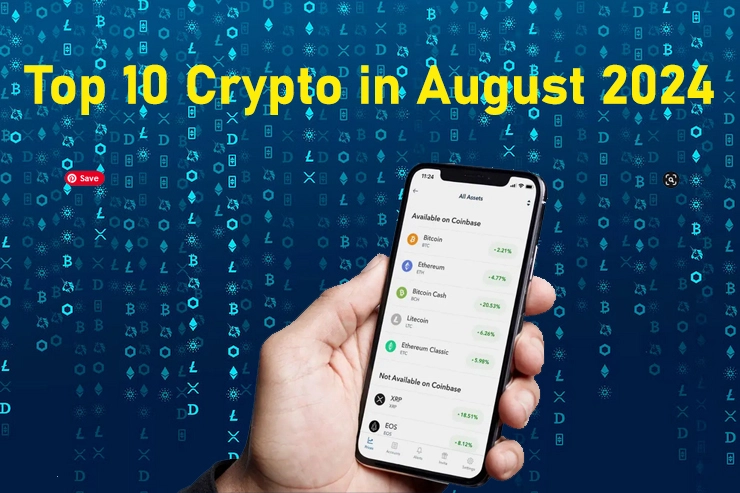The cryptocurrency market is notorious for its unpredictability and extreme volatility, yet it has delivered remarkable returns for long-term investors. This is likely why crypto enthusiasts remain optimistic, believing that the potential for price increases is limitless.
Despite the presence of thousands of cryptocurrencies, Bitcoin and Ethereum continue to lead the pack. Together, they make up approximately 71% of the global crypto market, valued at $2.08 trillion.
Below are the 10 largest cryptocurrencies by market capitalization, excluding stablecoins.

1. Bitcoin (BTC)
Bitcoin has consistently held the largest market capitalization and boasts the strongest liquidity among all cryptocurrencies, which we view as a clear indication of strong investor confidence. It is available on nearly every crypto exchange, making it an appealing choice for both individual and institutional investors.
Bitcoin’s primary purpose is to serve as a digital alternative to traditional currencies, functioning as both a medium of exchange and a store of value. Although it is already widely accepted in these roles, its volatility remains a challenge for everyday transactions.
However, Bitcoin’s capped supply of 21 million coins, along with the scarcity that this creates, its vibrant and active community, and the anticipated performance boost from April’s Bitcoin halving event solidify its position as the top cryptocurrency in our rankings.
Although the ongoing distribution of Bitcoin to Mt. Gox creditors might cause some market fluctuations in August, we believe that BTC is likely to reach new all-time highs once the situation stabilizes.
2. Ethereum (ETH)
Ethereum has long established itself as a dominant force in the cryptocurrency market, primarily as a leading platform for decentralized applications (dApps) and smart contracts. Its widespread availability and substantial daily trading volumes ensure that Ethereum remains accessible without causing significant price fluctuations.
Ethereum’s utility goes beyond just being a digital currency, with adoption spreading across various sectors like finance, gaming, and art. However, much like Bitcoin, Ethereum has faced its share of challenges, particularly with network congestion and high transaction fees.
To address these issues, the Ethereum 2.0 roadmap was introduced, featuring significant updates like the major “Ethereum Merge” in September 2022, the integration of Layer 2 solutions, and the recent Dencun upgrade in March 2024.
We also appreciated the introduction of EIP-1559 back in 2021, which shifted Ethereum’s tokenomics from an inflationary model to a deflationary one, gradually reducing its overall supply.
Ethereum’s development team, led by prominent figures like Vitalik Buterin and supported by the Ethereum Foundation, continues to innovate and improve the network. The ecosystem is further bolstered by Layer-2 blockchains, which build on Ethereum’s security while offering faster and cheaper transactions. Key players in this space include Polygon, Optimism, Arbitrum, ImmutableX, and Metis.
Despite facing recent challenges, such as the ETF outflows in late July 2024, Ethereum’s long-term outlook remains positive due to ongoing technological advancements and network upgrades.
In summary, Ethereum holds a solid #2 spot on our list. It will be interesting to see if it can maintain this position as new contenders rise in popularity.
3. Solana (SOL)
Solana, which launched in March 2020, has quickly gained attention for its ability to support dApps, smart contracts, and nonfungible tokens, similar to Ethereum. However, what sets Solana apart is its unique hybrid proof-of-stake and proof-of-history verification system, which allows for faster and cheaper transactions compared to Ethereum.
Despite these advantages, Solana has faced significant challenges, particularly with network stability. Since its launch, the network has experienced several major and partial outages, particularly since early 2022, which have raised concerns about its reliability.
While Solana’s supporters view it as a potential long-term competitor to Ethereum, its reputation as an “Ethereum killer” hinges on overcoming these stability issues and proving it can deliver consistent performance.
4. Toncoin (TON)
In 2018, the team behind the encrypted messaging app Telegram developed the “layer 1” blockchain, known as TON. This network is notable for its smart contract capabilities and speed, offering a significant advantage over Ethereum.
TON’s blockchain operates at an impressive speed of just five seconds per transaction. However, for Toncoin to truly compete with other cryptocurrency projects, it needs to attract more developers to its ecosystem. Toncoin has seen a surge in bullish momentum recently, driven by reports that Telegram is considering an initial public offering (IPO).
5. Dogecoin (DOGE)
Launched in 2013 as a parody of Bitcoin, Dogecoin (DOGE) has evolved into one of the most popular meme coins, with a dedicated and serious investor base. Despite its origins as a joke, DOGE has gained substantial attention, partly due to several high-profile supporters.
Tesla CEO Elon Musk is the most prominent advocate of Dogecoin, frequently referencing the cryptocurrency, which has led to significant price volatility. His influence has sparked controversy, resulting in a group of Dogecoin investors suing Musk, accusing him of deliberately manipulating prices. Another notable supporter is billionaire entrepreneur Mark Cuban, who has also expressed his backing of DOGE.
6. Cardano (ADA)
Cardano is a decentralized proof-of-stake blockchain that launched in September 2017, designed with a focus on energy efficiency compared to Bitcoin and other proof-of-work blockchains. The credibility of Cardano has been bolstered from the beginning by its founder, Charles Hoskinson, who is also a co-founder of Ethereum.
Similar to Ethereum, Cardano emphasizes functionality, making it an attractive platform for developers building dApps and verifiable smart contracts. ADA, the primary cryptocurrency on the Cardano network, is used to run dApps and facilitate transactions. By staking ADA, users can participate in verifying network transactions and earn additional tokens as a reward for contributing to the proof-of-stake system.
7. Cosmos (ATOM)
Despite being a relatively young blockchain—having released its whitepaper in 2016 and launched in 2019—Cosmos has secured a spot among the top 10 cryptocurrencies in 2024, serving as the backbone of the “internet of blockchains.”
Cosmos facilitates communication and collaboration between different blockchain networks, enhancing scalability, security, and functionality. This adaptable technology has been embraced by various projects for its ability to simplify cross-chain transactions.
The ecosystem employs a tokenomic model where ATOM tokens are used for staking and governance, playing a crucial role in securing the network and voting on key protocol decisions. The supply of ATOM is inflationary to encourage participation, with mechanisms in place to adjust inflation based on staking participation rates.
Supported by the Interchain Foundation (ICF) and developed by Tendermint Inc., Cosmos benefits from contributions from a global network of developers. Its vibrant community of developers, validators, and users actively engages in network governance and the growth of the Cosmos ecosystem.
Cosmos prioritizes security and operates under a transparent governance model, where all proposals and decisions are publicly accessible and subject to community voting. Its security is further strengthened by the Tendermint consensus algorithm, known for its robustness and efficiency. Additionally, the use of modular frameworks allows for customizable blockchains tailored to specific needs, enhancing overall performance.
In August 2024, Cosmos (ATOM) is navigating mixed market conditions, but potential growth is on the horizon through strategic partnerships and institutional integration. These collaborations aim to boost interoperability and cross-chain functionality, increasing the demand and utility of ATOM within the broader blockchain landscape.
8. Polygon (MATIC)
Polygon positions itself as a global network of aggregated blockchains. With daily active addresses reaching an all-time high of 1.3 million in April, it is well-equipped for growth in 2024, building on its established market cap and high liquidity.
Originally known as Matic Network, Polygon serves as a multi-chain scaling solution for Ethereum, aimed at providing faster and more cost-effective transactions within the Ethereum ecosystem. Its enhanced scalability and low transaction costs have made it a popular choice among decentralized applications (dApps), particularly in the DeFi and NFT sectors, enabling developers to build and deploy applications efficiently.
The MATIC token has a fixed supply cap of 10 billion tokens and is utilized for paying transaction fees, participating in network governance, and staking to secure the network. This tokenomic structure encourages the holding and usage of MATIC for network activities, supporting its overall value.
The development team at Polygon is dedicated to advancing the technology and maintaining its status as a leading scaling solution. Although the concept of Polygon’s business model could be replicated, it has successfully established a strong network effect that has contributed to its steady growth. It will be interesting to see how they can capitalize on this momentum for further growth opportunities.
As of August 2024, market sentiment remains positive, driven by Polygon’s increasing adoption and recent partnerships. The ongoing expansion of use cases in decentralized finance (DeFi) and non-fungible tokens (NFTs) continues to generate interest in MATIC.
9. BNB (BNB)
BNB is a cryptocurrency issued by Binance, one of the largest cryptocurrency exchanges in the world. Originally created as a utility token on the Ethereum network, BNB allows users to access discounted trading fees on the Binance.US exchange.
Since its inception, BNB has transitioned to Binance’s own blockchain, expanding its use cases beyond trading fees. It can now be utilized for a variety of transactions, applications, and other purposes. However, Binance’s market share in the U.S. faced challenges in 2023 following a lawsuit from the U.S. Securities and Exchange Commission, which alleged that the exchange violated securities laws.
10. Avalanche (AVAX)
Avalanche’s mainnet launched in September 2020, positioning itself as a fast and secure blockchain platform for developers to build decentralized applications (dApps). Like many cryptocurrencies, Avalanche aims to offer robust functionality, but it competes primarily with the Ethereum network.
One of Avalanche’s distinguishing features is its capped supply of 720 million tokens. The native token, AVAX, is utilized for governance and transaction fees within the network. Additionally, Avalanche employs a unique consensus mechanism that requires a sufficient majority of validators to approve a transaction, enhancing security and efficiency.
